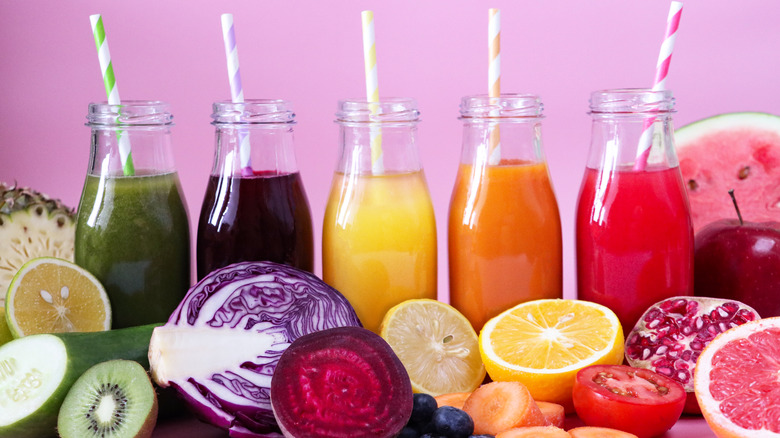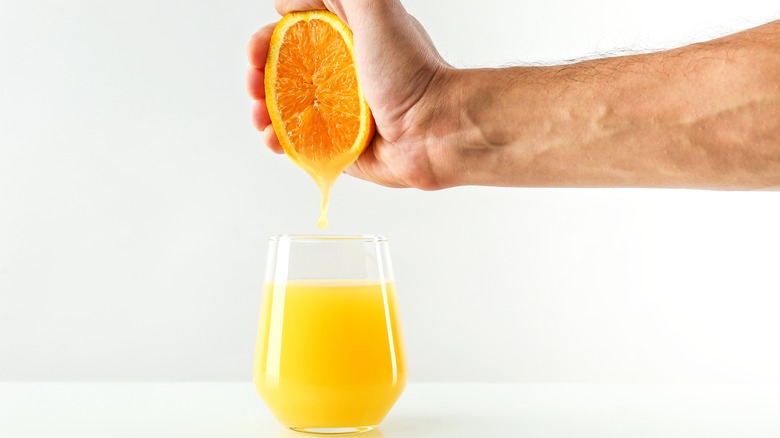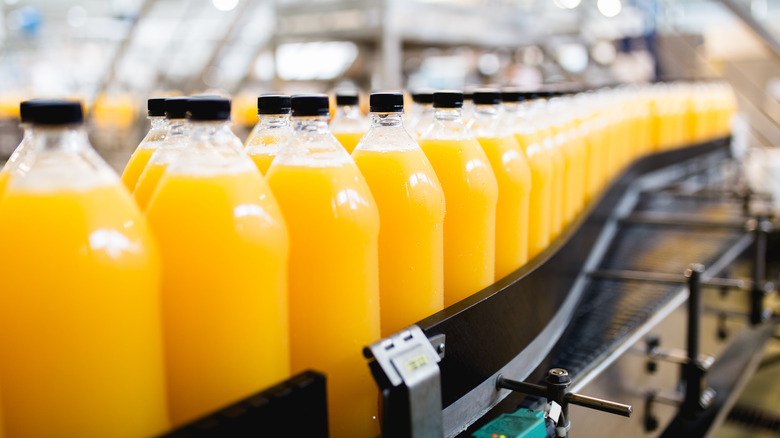Here's What A '100% Juice' Label Actually Tells You
When it comes to shopping for refreshing fruit juices, we are all attracted to a label that says "100% juice." After all, we are shopping for juice, and that label guarantees that you are getting what you actually want: a specific fruit or blend of fruits. When reaching for that bottle of orange, pineapple, or cranberry juice, you expect that your purchase will consist of only the juice shown on the label. But if you read the ingredients list, you might notice that not all 100% juices are the same.
The "100% juice" label on a product is intended to convey that the liquid inside the container is made entirely from fruit or vegetable juice with no extra sugars, preservatives, or other additives. However, although this label is regulated and monitored by food safety authorities, it's essential to understand that the term "100% juice" doesn't always tell the whole story. In fact, a bottle of 100% juice can contain juices from multiple fruits or veggies, liquid reconstituted from concentrate, and other additives.
100% does not mean 100% of one fruit
In the United States, the Food and Drug Administration requires clear labeling regarding the percentage of fruit and vegetable juices contained in bottled beverages. To qualify for the "100% juice" label, the drink must be made entirely of fruit or vegetable juices. However, just because it is entirely made of fruit or veg juices, it does not mean it is entirely made out of juice from only one type. In order to lower costs, beverage manufacturers sometimes add cheaper juices from fruits such as grapes, apples, or pears. So while the resulting product is still technically 100% fruit juice, it might not be 100% juice of the fruit you want. To make sure you are getting the right drink, it is best to check the ingredients label on the packaging.
Another fact about the "100%" juice label is that the juices are frequently still heavily processed. Since fruits such as oranges are seasonal, producers must hold the juice in storage in order to sell it year-round. Oxygen is removed from the juice to facilitate storage, but the same process also removes the flavor and aroma. To restore them, juice makers use "flavor packs," engineered by fragrance makers, and add them back into the juice in order to make it taste and smell fresh. This is why although the taste of fruits varies over time due to environmental factors, commercial juices taste more or less identical no matter when you purchase them.
Juice benefits and drawbacks
While the label "100% juice" can be a bit confusing, it does not mean you should abandon drinking juice altogether. A drink that is labeled 100% juice is still entirely made of fruit or veg — you just need to check to see which, and if the ingredients are in line with what you want out of a beverage. Juices from fruits and vegetables can be part of a balanced diet, providing an easy way for your body to absorb essential nutrients, minerals, and vitamins. However, as with anything, even 100% juices shouldn't be the only way we consume fresh produce. For example, according to WebMD, relying on juices for your recommended fruit and vegetable intake can cause underconsumption of dietary fibers.
To compensate for the lack of dietary fiber, you can replace juices with blended fruit or vegetables. Unlike juicing — which discards the fiber after extracting the liquid — blending fruits mixes the fiber into the juice, making it easy to consume. For instance, you can blend apples to make a quick juice that is also packed with fiber.



